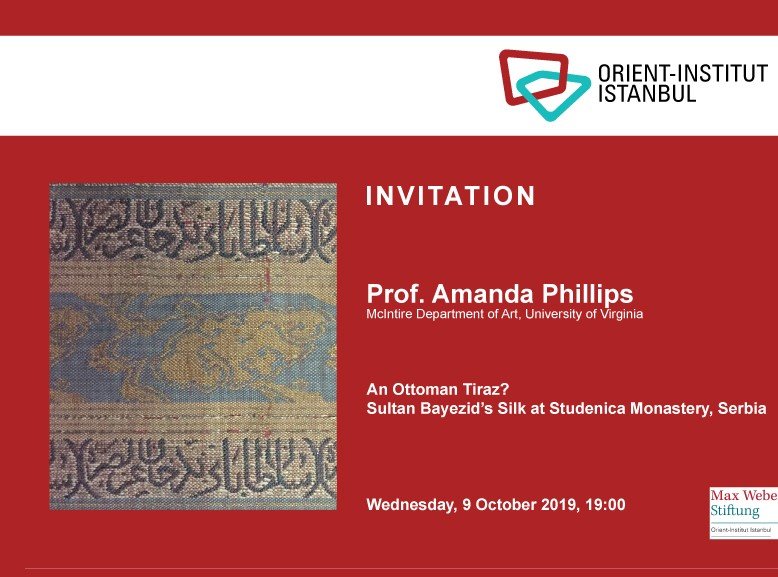Oktober, 2019
Details
The treasury of the Studenica Monastery in southern Serbia preserves the only known Ottoman textile attributed to the fourteenth century, a
Details
The treasury of the Studenica Monastery in southern Serbia preserves the only known Ottoman textile attributed to the fourteenth century, a massive silk hanging woven for Sultan Bayezid I. It was donated to the monastery in the very early 1400s by Bayezid’s widow, Mileva Olivera Lazarević (Despina Hatun). The textile’s two inscriptions—al-Sultan al-calim al-cādil and Sultan Bayezid Khan cazza nasruhu—suggest it was commissioned for the Sultan himself. This talk argues, however, that the manner in which the inscriptions relate to the textile as a whole is at odds with their ostensible message. Rather than a custom design, this silk was probably a rush-job from a workshop accustomed to making goods for a commercial market. This talk introduces the textile, which has received little scholarly attention to date, putting its main features in context of its production as well as discussing its place at Studenica. It also argues for the importance of looking beyond text and evaluating evidence found in objects themselves.
Prof. Amanda Phillips earned her DPhil in 2011 from the Khalili Research Centre for the Art and Material Culture of the Middle East at the Oriental Institute of the University of Oxford.
She joined the McIntire Department of Art at the University of Virginia in 2015, after finishing a Marie Curie-Gerda Henkel fellowship at the Centre for Byzantine, Ottoman and Modern Greek Studies at the University of Birmingham. Prior to that, she spent two years as a Max Planck-Kunsthistorisches Institut post-doctoral fellow at the Berlin Museum of Islamic Art.
Her research interests, and in turn her publications, focus on the economies of art and material culture in the early modern Islamic world. Amanda Phillips conducts research mainly on the decorative arts and most especially on silk textiles in Constantinople and the greater eastern Mediterranean. The topic itself encompasses Mediterranean trade, starting with the Renaissance aesthetic of the fifteenth century, and then stretches into the Indian Ocean while charting the fashion, taste, and materiality in the global eighteenth century. Among her publications are the monograph Everyday Luxuries: Art and Objects in Ottoman Constantinople, 1600-1800 in conjunction with the National Museums of Berlin (Berlin: National Museums and Verlag Kettler, 2016); “The Localisation of the Global: Ottoman Silk and Silk Weaving, 1600-1790,” in Threads of Global Desire: Silk in the Pre-modern World, eds Molà, Riello, and Schäfer, (Rochester, 2018).
Her second book Seachange: Ottoman Textiles Between the Mediterranean and the Indian Ocean, 1400-1800, is forthcoming with the University of California Press.
Zeit
(Mittwoch) 19:00 - 21:00
Ort
Orient-Institut Istanbul
Susam Sokak No:16 Kat:3 Daire: 7 Cihangir - İstanbul

